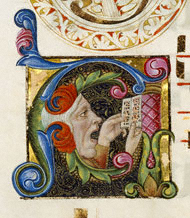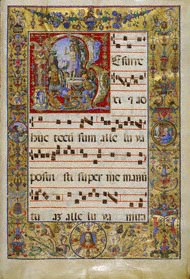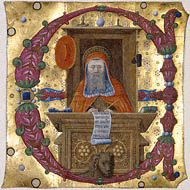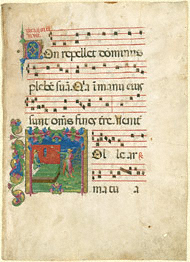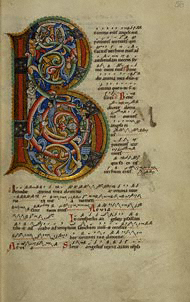| Education | ||
| Exhibitions | ||
| Explore Art | ||
| Research and Conservation | ||
| Bookstore | ||
| Games | ||
| About the J. Paul Getty Museum | ||
| Public Programs | ||
| Museum Home
|
August 14–October 28, 2007 at the Getty Center
Books containing music for Christian church ceremonies are among the largest and most beautiful manuscripts that have survived from the Middle Ages and the Renaissance. This exhibition explores the splendid decoration of these manuscripts and the significance of music in medieval religious life. The most lavish choir books are illuminated with biblical and allegorical scenes and even representations of the act of singing, as in this Initial A. Within the letter, a man shown in profile sings from an open book containing a chant and musical notation written on red staves. The illuminator depicted the sound of the singer's voice in the form of fine gold vines that emerge from his open mouth. |
||||||||||||||||||||
The Books of Song In monasteries and churches, musical chants were performed regularly during Christian liturgical ceremonies. Chants were a fundamental part of the mass (the public ceremony in which bread and wine are blessed and consumed) and the divine office (the prayer services celebrated by monks and nuns at eight specific times throughout the day).
|
||||||||||||||||||||
The Life of Christ In the most lavishly decorated choir books, illuminators enlarged the first letter of each hymn and filled it with an elaborate image inspired by the song's text. |
||||||||||||||||||||
The Lives of the Saints Medieval Christians regarded the saints as important role models and often appealed to them for help and spiritual guidance. Each holy man and woman was honored on a specific day of the year, when choirs would sing songs celebrating the saint's life. |
||||||||||||||||||||
Old Testament and Allegorical Themes Some decorative initials in choir books illustrate stories from the Hebrew Bible. |
||||||||||||||||||||
Writing and Transcribing Music In the 800s, European monks began to transcribe songs using a form of musical notation known as neumes, which are shown here above each line of text alongside an Initial B from the Stammheim Missal.
|
||||||||||||||||||||
Musical Performance and Devotion Along with spoken prayer, music was an important means through which medieval Christians expressed their devotion to God. |
||||||||||||||||||||
|
||||||||||||||||||||||||||||
